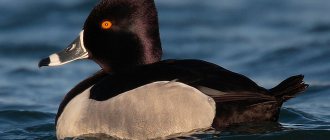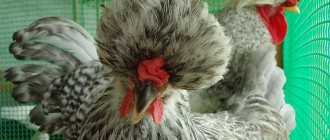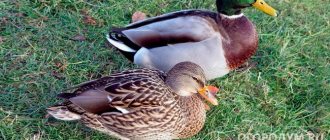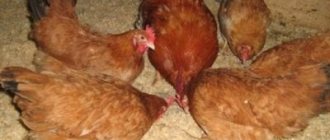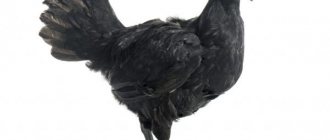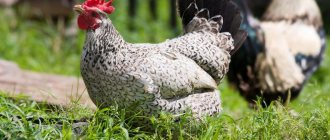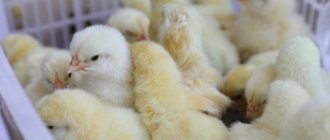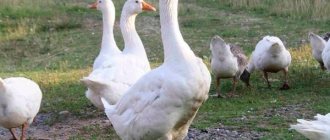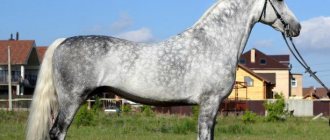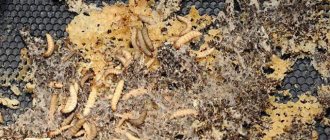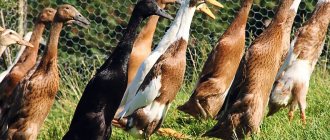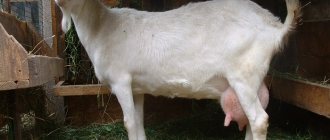Home » Articles about ducks » Tufted ducks
The main distinguishing feature of tufted ducks is the presence on their heads of a growth covered with long thin feathers that form something like a luxurious hat or crown. This decoration given by nature looks very original. This type of bird is valued mainly for its beautiful appearance. Although birds belonging to this group cannot boast of high productivity, their meat has excellent taste.
Maintenance and breeding
Tufted ducks of all breeds are undemanding and unpretentious to living conditions due to the presence of genes from wild duck ancestors. In the duckling house, it is important to maintain cleanliness and temperature and humidity parameters.
If the room is dirty and too damp, the birds get sick and look bad. Russian corydalis are the most susceptible in this regard. Russian corydalis are the most susceptible in this regard.
Tufted ducks can be kept in aviaries and cages, but they feel better free-range.
You just need to provide them with a place where it will be warm and dry during bad weather. If this rule is not followed (the shelter is blown by winds or water drips from the roof), the birds will feel uncomfortable.
The proximity of an open pond will allow ducks to swim and splash in the water, which is their favorite pastime. If this is not possible, then it is necessary to place several containers of water on the bird-walking area. Even small vats and basins will do.
When breeding crested cats, special attention is paid to the persistent preservation of the main characteristic of the breed - the crest. Even if both crested parents are present, this trait does not always appear in the offspring. The crested gene accumulates gradually and little by little from generation to generation.
If during crossing the male or female did not have a feather cap on their head, then the ducklings will also be without it. Some of the offspring will receive a forked, saggy and ugly crest. Feather decoration becomes visible on newly hatched chicks
The crested gene accumulates gradually and little by little from generation to generation. If during crossing the male or female did not have a feather cap on their head, then the ducklings will also be without it. Some of the offspring will receive a forked, saggy and ugly crest. Feather decoration becomes visible on newly hatched chicks.
Selective selection is carried out constantly. A duck family is formed from individuals who have consistently retained their crested appearance in several previous generations. It is necessary to inject fresh blood by purchasing breeding material for breeding on the side.
Nuances of breeding
Tufted ducks reach sexual maturity at 5 months of age. There are nuances in breeding such birds. Experienced poultry farmers advise crossing a crested individual with a bird without a crest. Using this technique, you can avoid splitting the breed trait. In this case, half of the brood will inherit the crest from one of the parents. The rest of the ducklings will not have it.
- Related Posts
- Colibacillosis in ducks
- Runner duck breed
- Aspergillosis in ducks
- Mandarin duck
- Feeding ducks from the first day of life
- Automatic drinkers for ducks
Keeping Tufted Ducks
Tufted ducks can also be kept in closed enclosures, but since they are an ornamental bird, they are usually bred in spacious ducklings, which are adjacent to equally large enclosures with ponds.
Tufted ducks need water
- Tufted ducks do not like crowding. There should be no more than 4 individuals per square meter of area. If there are more than 15 ducks in the room, then it is advisable to divide it into sections with special partitions.
- The room should be bright, with good ventilation, several light bulbs for additional lighting in winter. The most acceptable humidity for high productivity is 60-70%, temperature +16...+20 degrees. In winter it should not fall below +5 degrees Celsius.
- The bedding is made from hay, straw or sawdust, peat (can be combined). Change it when it gets dirty.
- The number or length of feeders should be sufficient for all birds. Approximately 15 cm of feeder is allocated for one adult.
- Not all tufted ducks need water, but it is still advisable to provide the bird with access to water, or at least a large trough of water so that the birds can splash around in it at will.
Facts about duck farming
Tufted ducks love to splash in the water. Therefore, it is best to raise these birds in places where there is access to a body of water.
Crested ducks can easily be kept in an aviary, but then it would be advisable to build an artificial small pond or bathing area where the ducks will splash and clean their feathers
The presence of birds near water bodies significantly increases the number of fish. In winter, in good weather, birds can be released outside.
When breeding, you must adhere to a daily routine. During oviposition, there is no need to move birds to another home. The crested drake and the female can live peacefully with other poultry.
High-quality breeding is ensured, first of all, by proper nutrition, a varied diet and a sufficient amount of vitamins.
The diet should contain:
- corn;
- cracked wheat;
- special feed.
Birds get vitamins from eating greens: you can give them spores, duckweed, and bush onions.
Breeds of wild ducks
Wild ducks primarily have a commercial purpose and are rarely used as ornamental ducks. The most famous representatives:
- Shoveler. A very peculiar bird, the distinctive feature of which is its wide beak. It prefers rivers among river bodies of water. Drakes have very beautiful plumage.
- Mallard. a very common variety. In our country it is found in most regions. Its close relative, the black mallard, lives in the Far East and Siberia.
- Pintail. Large birds with partly gray (chest and belly) partly brown (back and head) plumage in males and gray in females.
- Gray duck. Slightly larger than average for ducks.
- Wigeon. Medium size species. A special feature is the different sounds made by individuals depending on their gender. The male whistles and the females quack.
- Teal. It is divided into several subgroups, which include whistlers, codlings, as well as marbled or, otherwise, narrow-nosed teal.
- Killer whale. Range from Kamchatka to Eastern Siberia. A small bird weighing up to 800 grams.
- Mergansers. Birds with a narrow and curved beak. They live mainly in the forest zone. They are of medium size. Males weigh about 2 kg.
There is an even larger group of ducks distinguished by their method of obtaining food. They dive for fish. And, in fact, they are called diving. The most famous representatives: pochards, ducks and pink-headed ducks.
Ukrainian representative
The Ukrainian Crested Duck has a unique appearance and more than tasty meat, this is the reason for its breeding. Ukrainian ducks are very similar to common gray ducks. The characteristics of the breed are:
- variegated plumage, often they are black and brown, sometimes brown and gray;
- a light stripe wrapped around the neck;
- an oblong head with protruding cheeks;
- the beak is small, slightly raised;
- strong paws located close to each other.
The Ukrainian Crested Duck is weighty, reaching a weight of around 3 kg.
Tufted duck
Medium sized duck. The body length of the drake is 47 cm, the female is 40 cm. The weight of the male is 800 g. The body weight of the female is 550 g. Tufted ducks live in temperate climates, but sometimes they can be found in the forest-tundra zone. Their habitat is wide: Iceland, England, Ireland, Germany, France, Poland, Ukraine, Kazakhstan, China, Japan. In Russia, ducks settle in the Lower Volga region, the Urals, Altai, and Transbaikalia. The bird is commercial:
- The breeding plumage of the drake is elegant. It's black and white;
- the head is dark with a greenish tint. A long crest hangs from the crown and back of the head. It is formed by thin, long feathers. The crest can be smoothed or fluffed. In females it is not as pronounced as in males;
- The iris of a duck's eye is bright yellow. The eyes stand out against the dark background of the plumage;
- back, neck and chest are black. The sides, wings and belly are white. The mirror on the wings is formed by wide, long, snow-white feathers;
- the beak is gray with a black dot at the tip. The beak has a flattened shape;
- females have brown plumage. After the spring molt, drakes become the same, but not for long. In autumn they again acquire an elegant, discreet color.
The tufted duck lives in large bodies of water with coastal vegetation. Ducks feed on algae, roots, and plant seeds. During the molting period, they catch crustaceans and mollusks. Sometimes small fish are eaten. Cherneti are good divers. To pick algae, they dive to a depth of more than 6 m. Moving underwater, they make rapid movements with their wings.
Birds become adults at 2 years of age. They form pairs and build nests. For nests they choose dense vegetation near a pond. They often organize a place for laying in thickets of reeds or reeds. The clutch consists of 11 eggs. The female incubates the offspring for 28 days.
More on the topic: What properties does a duck egg have?
The drake does not take part in hatching. Males organize flocks and fly away to other lakes, where they moult. After the appearance of new plumage, they return again to the females. By this time she already has offspring. The drake and the female begin to teach the chicks how to get food.
Bar's Dive
This species of duck was named after the naturalist K.E. Baer: German by birth, headed the Russian Geographical Society in the 19th century. I explored the Primorsky and Khabarovsk Territories, where I discovered a colony of ducks with beautiful plumage. It is chocolate color with a silver tint.
The head of drakes is black. The flight feathers that form the mirror are white. Pochards have white irises. It stands out against the bright black background of the head plumage. Females are brown-brown and do not differ in brightness.
The female incubates the chicks. The chicks hatch after 30 days. Bar's pochard lives in colonies. Flocks of ducks can coexist with gulls and skuas. Pochards have to carefully hide their nests to protect them from destruction by birds of prey.
More on the topic: What types of meat ducks are there?
Breeding Features
Ducklings are born strong, with strong immunity.
Tufted ducks begin to lay eggs at 5-6 months. In a year they can lay about 120 eggs weighing 65-70 g. This type of duck can be bred either naturally or through an incubator. The chicks are born strong, with strong immunity. They grow very quickly, although breeders note that in winter the young animals slow down their development even with intensive feeding.
When breeding tufted ducks, individuals are sometimes born without a tuft. To ensure that the breed does not lose its species characteristics, only those individuals that have a crest should be left for breeding, and the rest should be discarded.
Egg production and procreation
Tufted ducks start flying around when they are 6 months old. Ducklings are bred using an incubator. From 12 to 15 eggs are placed under one lamp at a time. For 27 days, the chicks grow in a shell and in nests made of dry straw and hay at a temperature of 30 degrees.
After the ducklings are born, they must be separated from the main stock in a box to avoid injury. If desired, build a separate enclosure where the chicks will live for the first 14 days. Using a lamp, you need to organize the day for 20 hours, when the ducklings are one month old - for 12.
Interestingly, in the absence of an incubator, duck eggs are placed under a turkey or chicken. Strange birds mistake them for their own children.
In the first week of life, ducklings are fed six times a day. The diet consists of boiled eggs, cottage cheese with whey, mash and special vitamin and mineral mixtures. After seven days, greens, seeds, grains, and wheat are slowly introduced. The number of meals is reduced to 3 times a day. The little duckling grows quickly, in a month it gains up to 500 grams of weight and becomes independent. A mother duck walks her month-old ducklings to a pond, teaches them how to get food and care for their feathers.
Now you can easily distinguish the breed of crested beauty in a zoo or city square. Read more of our articles, like and share with your friends.
What types of ducks can be raised at home?
The duck family is divided into two large groups: domesticated varieties and wild ones. The former live only near humans, the latter mainly live in the wild, but if desired, they can also be kept in a farmstead. In turn, domestic species should be divided into 4 main classes:
- meat - large, fast-growing breeds with a solid body weight;
- egg-laying - produce more than a hundred eggs annually;
- universal - I demonstrate high achievements in both indicators;
- decorative - they have a bright appearance, and are grown to revitalize artificial reservoirs.
In each category there are a number of the most popular species that farmers breed most often
Table 1. Domestic species of ducks
| View | Breed |
| Meat | Moscow white Mulardy Rouen Musk Black white-breasted Favorite Peking |
| Oviparous | Indian runner Bashkir Khaki Campbells |
| Universal (mixed) types | Cayuga Swedish Blue Mirror Gray Ukrainian Orpington Saxon |
| Decorative | Carolina Shelducks Crested Maned Ducks |
Wild ducks include:
- Common mallards.
- Red-headed Pochards.
- Common goldeneyes.
- Killer whales (ducks).
- White-cheeked pintails.
Variety of species
How to choose the right option
Table 2. How to choose a breed?
| Illustration | Description |
| If the main goal is to raise large individuals for subsequent slaughter, then it is necessary to select representatives of meat species whose weight reaches 4 kg or more. | |
| If you plan to collect a lot of eggs, then you need to choose a breed with optimal egg production characteristics: 150-200 eggs per year (and even more). | |
| On a small farm it is more profitable to keep universal breeds. After the end of the reproductive period of females (after 2-3 years), it is possible to slaughter them and also obtain meat. | |
| In a small artificial pond it is worth placing several decorative individuals that are distinguished by their spectacular appearance. | |
| Wild ducks are also usually bred for ornamental purposes, but can also be kept for meat because they rarely get sick and require minimal care. |
How to breed and care
Yes, the facts speak about the ease of caring for birds with tufts, but for those who want to have tufted Russian ducks, it makes sense to take some points into account. The basis of the bird's diet should be mixtures of grains and dry grass. It is important to dry and ventilate the place where the wards live: this will be the key to their health. In damp and dirty conditions they tend to get sick. The Russian Crested is the most demanding.
Swimming in the water and looking for food on their own is a favorite pastime of these birds. It is clear that an open reservoir will best provide them with both. What to do if this is not possible? Then it is necessary to place containers with water in the birds’ daytime area. Purity of the species can be achieved only if both the female and male with a crest are of the same breed, otherwise there is a risk of getting ordinary chicks, and not handsome ones with crests.
Decorative breeds
In recent years, duck breeding has become increasingly popular, as they say, for the soul - so that waterfowl enliven artificial ponds and pools with their presence. For this purpose, varieties with a spectacular appearance are most often selected. Usually they are not of interest in terms of meat production due to their small mass - less than a kilogram (800-900 g).
Shelduck
Among the most common is the Shelduck duck, which is quite large: up to 68 cm in length and up to one and a half kilograms in weight. It can be recognized by its beautiful tricolor plumage and unusually shaped beak.
Shelduck
Mandarin duck
The multi-colored mandarin duck is one of the smallest in the family, its height does not exceed 50-55 cm. But due to its spectacular appearance, it can decorate any artificial pond.
Mandarin duck
Tufted duck
Tufted ducks are distinguished by a tuft of feathers on their heads, which is how they get their name. Their plumage can have different colors. Including snow-white or completely black. They can be bred not only for decorative purposes, because adult individuals often grow up to 2 kg and produce up to 50 eggs annually.
Crested variety
History and description
Images of tufted domestic ducks are found on the canvases of Dutch painters of the 17th century:
| Tufted domestic ducks in the paintings of Melchior de Hondekoeter (Netherlands, second half of the 17th century) |
The Tufted Duck was also known to Charles Darwin, who considered it one of four subbreeds of the common domestic duck.
.
In 1868, Darwin compiled a fairly detailed description of the tufted (Dutch) duck:
| ...3) Tufted duck, with a large spherical crest on the crown, made of delicate fluffy feathers; it sits on a fleshy mass; a skull underneath with holes. One duck I received from Holland had a crest two and a half inches in diameter. |
Regarding the Ukrainian, Darwin made the following conclusion:
| A crest of feathers is by no means a rare phenomenon among ducks; it is observed in the true crested breed, in the hook-billed, in the common breed of our poultry yards, and was found in one duck sent to me from the Malay Archipelago, which had no other characteristics. The crest is interesting only in that it affects the skull, which becomes somewhat rounder and receives numerous holes. <…> One Dutch crested duck had a skull under a huge crest that was somewhat more convex than usual and was pierced by two large holes. The protrusion of the lacrimal bone in this skull continued further back, so that it had a different shape and almost touched the posterior lateral process of the frontal bone*, so that the orbit of the skull was almost closed from below. * Postorbital process.—Approx. translation |
Darwin also provided measurements of the skeleton of a tufted duck:
- The length of the thigh, shin and metatarsus together is 8.25 inches (21 cm).
- The length of the humerus, radius and metacarpus together is 9.83 inches (25 cm).
- Their ratio is 100:119.
- The weight of the femur, tibia and metatarsus is 111 (7.2 g).
- The humerus, radius and metacarpus weigh 148 grains (9.6 g).
- Their ratio is 100:133.
- The weight of the entire skeleton is 1404 grains (91 g).
- The weight of the thigh, tibia and metatarsus is 111 grains (7.2 g).
- Their ratio is 1000:79.
- The skeleton weighs 1404 grains (91 g).
- The humerus, radius and metacarpus weigh 148 grains (9.6 g).
- Their ratio is 1000:103.
What to feed tufted ducks
To feed corydalis, a balanced diet is prepared. It should contain grains, legumes, and corn. It is advisable to add rapeseed or sunflower cake and bran to the mash. Fresh mash is given approximately once a day. They are made from chopped vegetables, herbs. Without fail, yeast, meat and bone meal, fish meal, and salt are added to bird feed, at least in small quantities.
Important! If you let ducks out to swim in ponds, you can significantly reduce feed costs, because you don’t have to feed the birds during the daytime walk. In order for the food in the stomach of ducks to be digested well, it is necessary to pour crushed shells, fine gravel, and ground eggshells into a separate bowl for them.
They eat this mixture as needed.
In order for the food in the stomach of ducks to be digested well, it is necessary to pour crushed shells, fine gravel, and ground eggshells into a separate bowl for them. They eat this mixture as needed.
If the animals are not allowed to walk, they must be given food 4 times a day. In the evening and morning they give dry grain mixtures, and in the afternoon - wet vegetable mash. If the bird walks during the day, then you can feed the ducks 2-3 times a day, because the birds find a lot of fresh food while walking. The water in drinking bowls is changed as often as possible so that it does not have time to run out or become contaminated.
The tufted duck is considered one of the most beautiful domestic birds. The breed originated in the 17th and 18th centuries when farmers crossed ducks imported from China with local breeds. A characteristic feature is the crown-like crest growing on the back of the bird's head (sometimes called a horned duck). The species has a friendly and active character. Ducks have a clear voice and the sound can be heard far away.
The tufted duck has many subspecies. Among them are the merganser - duck with blackhead, domestic Russian, Dutch and Ukrainian. This variation is explained by the fact that duck is popular among poultry farmers and is widely used due to its unique appearance.
Story
It has not yet been possible to accurately determine the year and history of breeding of the breed. Breeders suggest that the domestic crested duck was the result of an accidental or artificial crossing of the Chinese crested duck and European poultry.
Representatives of this breed were brought from Southeast Asia to Holland more than 3 centuries ago. For a long time, corydalis were bred only in this country, which is why the breed received the second name “Dutch”. Tufted ducks can be found in the paintings of many Dutch artists of the 17th and 18th centuries.
In the 18th-19th centuries. Corydalis spread throughout all European countries, which made it possible to develop new varieties of the breed.
Egg breeds of ducks
A bird with this breed weighs less than meat and all-purpose ducks. But their egg productivity is almost the same as that of egg-laying chickens.
Indian runners
Even a novice poultry farmer who has seen ducks of this breed at least once will not confuse them with its relatives. Why? The point is the uniqueness of the exterior of Indian runners.
They can be visually recognized by their narrow body (torso), positioning of the limbs (like penguins), small head and large wedge-shaped beak, thin and long neck, and raised tail feathers.
- The name of the breed itself says that we are talking about long-legged ducks.
- There are white, piebald, ash (various shades), and black runners.
- Live weight of representatives of the breed: drakes – 2 kg, ducks – up to 1.8 kg.
One of the obvious advantages of the breed is that in summer the bird gets by with an ordinary basin of water. In addition, such ducks tolerate harsh winters well and do not show aggression towards birds of other breeds and even species.
And now about the most important thing - egg productivity. Females are capable of producing more than 330 eggs annually. In many organoleptic properties, runner eggs are superior to chicken eggs. Their weight reaches 80 grams. Probably, the owners of egg chickens began to envy.
Although the breed does not shine with meat productivity, the meat of runners is harmless to people who are obese. There is very, very little fat in the meat (that’s why they are runners).
Description and characteristics
Ducks with a tuft on their heads are not large in size, but have a dense and muscular build. The back is wide and long. The chest is round, slightly convex. Crested ducks are characterized by an elongated, narrow and thin beak. Their neck is quite short and bends forward slightly. The limbs and wings are not very developed.
The plumage is hard, thick and dense, having a wide variety of colors. The color of the feathers is determined by the parent breeds that participated in the crossing. The dependence of the color of feathers and beak was noted. The darker the feather, the more richly colored the beak.
The main advantage of tufted ducks is the presence of a characteristic tuft on the head, consisting of thin and long feathers.
When breeding these birds, out of the total number of ducklings hatched from eggs, 1/5 appears without crests. This is explained by the fact that the crested gene has cumulative qualities that are lost if one of the parents was deprived of this trait.
The birds are agile and light; aggressiveness is not typical for this breed. The productive characteristics of corydalis are low. Adult drakes rarely gain more than 3 kg of weight, while the female often does not reach 2 kg.
Popular meat varieties
Large breeds of ducks, which are bred for slaughter, are most in demand among farmers. These birds have very tender and tasty meat, which is considered a real delicacy. Maintaining even a large population of several dozen individuals is not too expensive, because waterfowl are omnivores, with good feeding they grow quickly and gain weight, so young animals can be slaughtered after 97-12 months.
Peking ducks
The leader in popularity is the Beijing variety
It combines all sorts of advantages that poultry farmers primarily pay attention to. Representatives of this breed extremely quickly reach a solid meat weight - 1.5-2 months after hatching
After three months, the birds weigh 3.6-4 kg and can be slaughtered. And this is even with a standard diet - ducks are not whimsical in this regard, regular feed is enough for them.
They also do not require any special conditions of detention, which is also a significant advantage. At the same time, the females also lay well - a little more than a hundred fairly large (90 g) eggs annually. The external characteristics of the Pekin are completely white (without markings) vestments, legs and beak of orange color.
Beijing variety
Black white-breasted duck
An interesting meat cross is the Black White-breasted ducks, obtained by scientists from the Ukrainian Poultry Research Institute, who combined the genes of the three largest varieties: Khaki Campbell, White Russian and Pekin. The result was a hybrid with meat of high fat content and solid weight indicators - 4-3.8 kg. The appearance of the birds is quite remarkable: a dense body with an open chest, powerful wings and back, and muscular legs.
The color is almost completely black, and there is a large white spot on the front of the body. Representatives of this breed grow quickly and can go to slaughter at the age of 3-4 months. The advantages include the high survival rate of young livestock - 96 individuals out of 100, omnivorousness and good immunity. A significant drawback is the low hatching percentage - 65 out of 100.
Representatives of the Black White-breasted variety
Mulards
The Mulard species belongs to the broiler class and is an artificially bred hybrid (based on the Peking and Musk variety). These are record holders among meat varieties, because young animals reach the 4 kg mark at three months of age, but do not stop there and continue to grow. The peak level is 6 and even 7 kilograms.
This species does not lay eggs well, and the hatching rate of ducklings is extremely low. This is a meat variety that can only be kept for the sole purpose of being slaughtered for meat.
Mulard ducks
Muscovy duck
Representatives of the Musk breed, also known as Indo-ducks, are endowed with a specific smell, since South America, the habitat of aboriginal Indian tribes, is considered their homeland. They are also very large birds, gaining weight up to 6 kg upon reaching sexual maturity.
It is better to slaughter young animals after 3 months - before the first molt, otherwise the meat may become tough. This species can be easily recognized by the characteristic pink warty growths on the beak and the adjacent part of the head. Indo-duck meat is dietary and contains very little fat, unlike other varieties.
Musk breed (Indochka)
Rouen duck
The Rouen variety is named after its place of origin, as it was developed in northern France. Breeders set out to create a meaty species with very high quality fillets that could be used in haute cuisine recipes.
In addition, when the calorie content of the diet increases, birds gain fat very quickly, which makes it possible to obtain from them extremely tender fillets with translucent fat, which is considered a special delicacy. The optimal weight for mature individuals is 5.3 kilograms.
Ducks from Rouen are famous for their variegated plumage, and the drakes have a bright emerald head and a white necklace.
Moscow white duck
The Russian breed, one of the most popular in our country, is the Moscow White. In appearance it resembles the Pekin, from which part of the genetic material for selection was borrowed. The second “donor” was the Khaki Campbell species. Individuals are quite large - 4.5 kilograms when reaching sexual maturity, and have tender, not fatty, but juicy and tasty meat.
This species is characterized by snow-white plumage without a hint of yellowness (which is characterized as culling) and a rich red beak color.
Moscow variety with white plumage
Breeds
Ducks got their name because of the white color of their feathers, due to the presence of a recessive gene that is passed down from generation to generation through both the male and female lines. Popular breeds of white duck include Blagovarian, Moscow, Aylesbury, Crested, and Indian runners.
Blagovarskaya
Ducks of the Blagovarian breed appeared relatively recently in Bashkiria. At a poultry farm for the production of new breeds of poultry, this breed was bred by selecting the Medeo breed.
The distinctive external features of the Blagovarian bird are as follows: quite impressive size, wide chest and dorsal part, large head and beautiful curved neck part. The feathers located on the tail stick up and are located tightly to each other, forming a bunch. The beak and paws have a yellow-orange tint. The plumage is white and fits tightly to the body.
Blagovarian ducks are active, calm, and adapt well to changes in the flock. The advantage of the breed is that it consumes a small amount of food while gaining good weight. They place high demands on food for a balanced daily diet. If they don't eat well, they stop gaining weight. Blagovarian ducks are raised in Belarus, Ukraine, Russia, and Kazakhstan.
Blagovarsky white ducks lay up to 240 eggs annually weighing about 95 g. At the age of 60 days, the average weight of a duck is about 3.4 kg, and that of a drake is 3.7 kg.
Moscow
The Moscow white duck was bred by crossing a Khaki Campbell duck and a Peking duck. This breed of birds is characterized by the following advantages: resistance to diseases, high productivity, and quickly adapt to temperature changes. A mandatory requirement during the cold period is daily walks in the fresh air. Due to their widespread use, the cost of purchasing chickens for raising is low.
In terms of external features, the Muscovy duck is distinguished by a massive body with a large chest, a straight back, and a short tail. The male Muscovy duck has several feathers on its tail curled into a ring and a large head. The beak is colored deep pink, the paws are orange.
The Moscow duck annually brings about 150 eggs weighing up to 90 g. The weight of the laying hen at 60 days is 3.5 kg, the drake’s weight is up to 4 kg.
Aylesbury
The Aylesbury breed was developed in Great Britain and then spread throughout Europe. The birds have snow-white plumage, a massive body, blue eyes, a wide dorsal and chest, and a large head. The beak is wide and strong, orange in color, as are the paws. Their advantage over other varieties is their developed maternal instinct and rapid weight gain. They belong to meat ducks: the female weighs 3.5 kg, the male – 5.5 kg. Only 95 large duck eggs weighing 90 g are brought per year.
Crested
The Crested breed was most likely developed by crossing local breeds of ducks with Chinese Cresteds. The white crested duckling is small in size with a convex chest and dorsal part, with a neck inclined downwards. The bird's wings are long, tightly fitting to the body. The beak and paws are orange. Farmers believe that the larger the crest on a duck's head, the fewer eggs it will produce. The advantages of the breed are tasty and lean meat, calm character. Egg production is low - only 120 pieces per year weighing 70 g. The weight of a female is 2.5 kg, a male is 3 kg.
Indian runners
Indian runners were obtained in the 19th century from penguins and brought to Europe as an ornamental breed for zoos. They belong to the egg breeds and are widespread in Ukraine and Russia. In appearance they resemble penguins. The bird's body has a cylindrical elongated shape, snow-white plumage, an elongated head, and a long and thin neck. The beak and paws are colored yellow.
Advantages of the Indian Runner duck breed: high egg production - up to 350 pieces weighing 70 g, calm character, tasty and lean meat, unpretentiousness in nutrition. The main disadvantage is its low weight, which does not exceed 2 kg.
Beijing
Peking duck comes from China. It belongs to the meat breeds and is widespread among poultry farmers. The main disadvantage of the breed is its restless nature. The main differences between Peking duck:
- elongated massive body with a wide chest and dorsal part;
- long curved neck, large head, concave forehead;
- the beak and paws have an orange tint.
Birds lay up to 120 eggs during the year. Their weight is quite large - up to 90 g. The maximum weight of a female Peking duck is 3.9 kg, a male one - 4.2 kg.
All about the Tufted Duck breed
Domestic ducks with large crests on their heads are one of the oldest breeds of ornamental birds, which have, incl. and some economic value.
There are several varieties of the breed, which differ in external characteristics and requirements for living conditions.
The tufted duck is light in weight, but has good egg production and a beautiful appearance.
Description and characteristics
Ducks that have a voluminous cap or crown of long, thin feathers form a breed group. All breeds that are part of the corydalis group are distinguished by similar external characteristics:
- Dimensions. Corydalis are small in size compared to Mulards or other meat breeds. The weight of the bird, depending on the variety, is 2-3 kg (for ducks) or 2.5-3.5 kg (for drakes).
- Body type. Despite their small size, crested birds are distinguished by well-developed muscles and dense build. The duck's body is elongated, its back is wide and long, and its chest is slightly convex and rounded. The neck of the corydalis is short and protrudes slightly forward. The beak is of medium or short length and oblong in shape. In some breeds it is slightly raised. The legs of ducks are short and powerful; the length and appearance of the wings depend on the type of breed.
- Plumage. The feathers of the corydalis are thick, dense and hard to the touch. The color of the bird depends on the parental genotypes. Common to the entire breed group is a direct relationship between the color intensity of the feathers and beak: ducks with dark colors have a brighter and darker beak.
- Manifestation of a gene in phenotype. The gene that determines the presence of a crest, the main breed characteristic, is manifested in the phenotype (appearance) of the duck in only 80% of cases. If one of the parents does not have a crest, the hatched ducklings will not have this feature.
- Productivity. The productivity of ducks is low: they can grow quickly, but the weight of an adult does not exceed 3-3.5 kg. Corydalis are often raised for their eggs. The productivity of birds inversely depends on the size of the crest: ducks with large feathered crowns are raised primarily for decorative purposes.
The Crested Duck is active, non-aggressive and mobile.
Bashkir Crested breed
We recommend reading our other articles
- Growing melon in open ground
- How and why horses are bred, how to make a business out of it
- Charolais cow breed
- Foxy Chick Chickens
Photo of Bashkir Crested Duck
This variety of corydalis differs:
- increased endurance;
- high egg production;
- unpretentiousness.
At the same time, the disadvantages include the fact that Bashkir ducks can only be kept near water bodies, otherwise productivity decreases and the appearance and quality of feathers deteriorate.
Important!
In terms of body weight, Bashkir crested ducks are inferior to Ukrainian and Russian species. Because of this, they are less popular and are bred mainly by fans of this breed.
The bird's physique is powerful and its bones are strong. The chest is protruded and covered with soft, dense feathers. Legs are strong and set wide. The bird is distinguished by beautiful, large wings. The neck is of medium length, rather thick. The color of the bird comes in several types: white, black-brown, gray, gray, brown. The main feature of the species is the bright patterns on the wings.
Pros and cons of the breed
Tufted ducks have the following positive qualities:
- beauty of plumage;
- unpretentiousness in maintenance and feeding;
- edible and soft meat;
- ability to hatch eggs well.
A farmer who wants to breed this breed should also be aware of the shortcomings that are sometimes so acute in birds:
- low productivity;
- in ducks, signs of crestedness often disappear, therefore it is necessary to carry out constant selection work to preserve it;
- it is difficult to find ideal individuals for breeding and obtaining purebred chicks;
- the average egg production rarely exceeds 60 eggs per year from one duck;
- there is an urgent need to keep the birds’ home clean.
A decorative duck will be a good choice for decorating your yard. Its unusual appearance will add zest to any household.
1691Article ratingKira Stoletova
Among all the variety of birds, tufted ducks are considered one of the most spectacular. History says that they appeared as a result of crossing an overseas guest from China with European ducks. And for 300 years this breed has been decorating the lands of European and Russian farmers. The Russian crested bird is more decorative than meat. They call her crested because she has a cute crest on her head.
Tufted ducks
Breeding and selection
The main problem plaguing breeders is the preservation of the crest. In ducks, signs of tufting and plumage quality often disappear. To prevent this, you need to make sure that both partners have tufts. If at least one individual does not have it, half of the offspring will also not have it. The chance of losing an accessory is high, even if both tufted ducks have a pure breed.
It is important to always select large individuals, without defects, in order to obtain healthy and fertile offspring.
There may also be other disadvantages if this rule is not followed:
- the crest may be small and hang to one side;
- the crest may be forked;
- there may be a fold on the abdomen;
- critically large or small body.
Different subspecies have varying conditions for growing and keeping young animals. The general thing remains the possibility of incubating eggs, maintaining the diet and proper routine for the duckling.
Tufted duckling
Care
Russian Crested (chicken breed)
Ducks are unpretentious in keeping. They feed on any food, preferably dry grasses and grains.
Important: you can arrange a small pool for the birds in the aviary, this will have a positive effect on the mood of the entire flock. Ducks will frolic in it, dive, get food
Duck housing must be clean and dry. Dirt and dampness cause discomfort to the bird and can cause illness. The floor of the poultry house should be cast concrete or lined with brick. This will prevent moisture and dirt from penetrating inside. The floor must be covered with bedding. Sawdust, hay or straw are used for it. Everything is sprinkled in an even layer 5-10 centimeters thick. The exit from the house leads to a fenced enclosure where the bird spends most of its time.
If there are ducklings in the house, there is an urgent need to maintain a high temperature. When breeding ducklings at home, it is necessary to have heating equipment, which is installed in the poultry house.
The ducklings are fed as soon as they hatch and dry out once every two hours. For food you need to prepare porridge from crushed boiled eggs mixed with grain. Fresh greens are also necessary for chicks - any fresh grass is used.
Important: in order for the chicks to grow up healthy, you can give them cottage cheese soaked in whey
Feeding
You can feed corydalis with balanced feed intended for ducks, or with homemade mash and grain mixtures.
Duck feed may contain the following components:
- crushed grains of corn, barley and wheat;
- legumes;
- cakes of oil crops (rapeseed, sunflower, etc.);
- bran;
- yeast;
- green mass and silage (young nettle, alfalfa, steamed hay, etc.);
- vegetables (boiled potatoes, carrots, cabbage, beet pulp, yellow pumpkin);
- meat and bone and fish meal;
- cottage cheese (added to ducklings’ feed);
- gravel, coarse sand;
- ground eggshells, shells;
- salt (up to 0.2% of feed).
If there is an open reservoir nearby, part of the green mass in the diet consists of aquatic vegetation (duckweed, pondweed, etc.). Using pasture allows you to reduce food portions by 20%.
If there is no pond and the animals are kept in enclosures, food should be given in full. The number of meals can be up to 4 per day. 50% of the daily diet should be dry grain feed, and another 50% should be wet mash, including grains, bran, vegetable additives and yeast.
In winter, tufted ducks practically do not gain weight, but the amount of food cannot be reduced. In cold weather, bird food must include potatoes, hay, rot, fish or meat and bone meal and mineral supplements.
Combined breeds
If your plans include a small backyard farm, then this is your option for ducks. Due to their versatility, 2-month-old ducks weigh 1.5 kg.
Khaki Campbell
Representatives of this breed are the result of the work of an Englishman who worked on his selective herd in the 19th century. Plumage color options are brown and khaki. Drakes have heads, necks and chests that are colored differently than females.
You can also identify the bird by its dark green beak. It is noteworthy that with a somewhat elongated body, ducks of this breed have too short legs. We can talk about a certain disproportionality of development. The breed is good because it shows high productivity when fed algae and pasture grasses.
With a good food supply, males gain three kilograms of weight. And females weigh around two kg. Average egg production is 175 eggs per year.
Mirror breed
A bird of domestic selection, which was created on the basis of such breeds as Peking (maternal breed) and Khaki Campbell (paternal breed). The plumage color is light brown.
There is a white border on the chest of males. And on the wings there is a so-called “mirror”, which is how drakes differ from females. Day-old females are covered with light brown, males with grayish down.
A bird at the age of 2 months weighs 2 kg. The female produces 120 eggs per year.
Negative characteristics of the breed
- The presence of a crest is not noticed in every representative of the breed, because it appears only if both parents have crests.
- The breed of tufted ducks has a property - it dissolves even if there is no mixing of blood. In crested drakes and ducks, 5% of the offspring are born without a crest. A gene that has a cumulative property is responsible for this. If it has not accumulated, then the young will hatch without crests.
- Average productive qualities are low, since most often drakes weigh about 3 kg, and ducks - a little more than 2 kg.
- Average egg production is 60 eggs.
A crested chick is not always born with a crest.
Ukrainian Corydalis
Black duck - description, name
This breed has a lot in common with its Russian counterparts, but differs in small details:
- the neck is slightly curved;
- the head has a rounded-oblong shape;
- the eyes have a slight shine, the color is brown;
- the body is large, the weight is also appropriate;
- on the neck there is a strip of light feathers, reminiscent of a necklace;
- the beak is medium, has a slight bend;
- the paws are powerful, not too far apart from each other;
- the plumage is dense and bright. Closely adheres to the duck skin.
The Ukrainian Crested, like its Russian relative, also does not weigh much. The weight of the drake ranges from 2 to 2.5 kg, and the weight of the female does not reach 2 kg. They also lay eggs all year round. The weight of the egg is the same as that of the Russian breed - about 60 g. They are white in color, and occasionally there are eggs with a greenish tint.
The breed is not a meat breed, although it is sometimes used as food. Like its Russian relative, it is used for decorative purposes.
Ukrainian CorydalisChinese Corydalis
Chinese Corydalis in an antique Chinese engraving
This is a wild tufted duck, which is also sometimes called the mottled shelduck. She belongs to an endangered species. Its main features are plumage. The feathers on the back are dark brown, while the belly, sides, neck and cheeks are white. The chest is black and green. The bird is bright, beautiful, and has a high decorative value.
Important!
The Chinese Crested Duck is a very good swimmer and feeds mostly from water bodies.
Features and differences of the breed
The Crested is considered a light and agile bird. It is non-aggressive and, despite its small size, has well-developed muscles. A description of ducks of this breed will be incomplete without mentioning their main feature - the tuft on the back of the head. It indicates the purebredness of the breed. It is also thanks to him that the crested bird has become so popular among fans of ornamental birds.
And it doesn’t matter what color the feathers on the crest are, the main condition is that they must be long and thin
The bird has a short but dense neck and a small beak. It has not very developed wings and limbs. Thick plumage complements the picture with a variety of colors. The color of the feathers depends primarily on where the duck lives, as well as on the manifestation of the blood of other breeds with which it was crossed. A notable point is that the darker the bird, the darker its beak.
Unfortunately, even when crested drakes and ducks are involved in breeding, about a fifth of the chicks are still born without crests. The whole question here is in genes: the lower the gene concentration tufted ducks have, the fewer purebred babies appear.
There is another feature of the breed - low weight. An adult male rarely reaches 3 kg, and a female weighs no more than 2 kg. The egg does not weigh more than 80 g. Most often, no more than 55 such eggs per year can be produced by one young individual. The recorded record for this breed was 120 pieces, but this is rather an exception.
Genetics
The development of a spherical crest on the back of the head from short down feathers in Dutch ducks is determined by the presence of the crest gene in their genotype. In the homozygous state, this gene causes the death of the embryo while still in the egg. Therefore, all crested individuals are heterozygous for this trait, that is, they carry only one copy of the lethal allele of this gene. Homozygous embryos (with two copies of the lethal allele) are produced in a quarter of the offspring from a cross between two crested individuals, inheriting the lethal allele from both parents. Accordingly, in order to obtain crested offspring, but avoid segregation of homozygotes, duck breeders mate a crested individual with a crestless one, as a result of which the offspring are split according to this trait in a 1:1 ratio. Half of the ducklings are tufted, and half are without a tuft.
Description of the breed
Gray Ukrainian ducks have good immunity and appetite. They love freedom and cannot do without water. The active bird is constantly looking for food in the pasture and grows quickly.
Appearance
The gray Ukrainian duck has a beautifully built body. Its elongated body is slightly raised forward. The bird's muscles are well developed. She has a wide back and chest. There is no wedge-shaped process on the duck's belly. The head, set on a neck of medium length, has an oval shape. A distinctive feature of birds is their increased density of down. Based on the type of plumage color, birds are divided into:
- White. These ducks have white feathers and an orange or bright yellow beak.
- Clayey. Birds of this species have brown plumage, a green beak and red and orange paws.
- Wild feathered. The most common type. These ducks may have golden or chocolate brown plumage. Males have a white non-closed ring in the neck area and shiny blue-green feathers. In summer, males molt and become similar to females. The beak of wild-finned ducks has an olive color. There is a black spot at its tip. The bird's feet are orange.
- Gray. This type of duck is similar to the mallard. The backs of the birds are covered with feathers that have black and brown plumage. The wings of ducks and the lower part of the body are painted gray, the sides have a shiny blue tint.
Breed characteristics
The gray Ukrainian duck is a heavy meat breed. The average weight of an adult female is 3 kg, a male is 3.5-4.0 kg. Birds reach this weight by 4 months. At the age of 2 months, ducklings weigh about 2 kg. This is enough to start slaughtering them. The meat of young ducks is especially tender and soft.
The breed of gray Ukrainian ducks is characterized by rapid growth. The survival rate of ducklings is 95-97%. Adults have a large amount of fluff in their plumage. With proper nutrition and care, gray ducks can show good egg production results.
Features of behavior
Despite the great love of ducks for splashing in water, there is no need to build a large artificial pond for them. It is quite enough to provide deep troughs for them. Gray Ukrainian ducks have a very friendly character. They can do well with most types of pets. Large crowding of birds causes them anxiety, which leads to a decrease in egg production. It is recommended to place it on 1 sq. meter no more than 3 ducks.
Ukrainian gray ducks are very talkative. Their quacks can be heard far from their habitat. The drake's voice is very similar to the croaking of a crow. Females are more vocal. In warm weather, ducks try not to gather in flocks.
The main purpose
Gray Ukrainian ducks are a fast-maturing meat breed. At home, it is bred not only for meat. The bird flies well and produces a lot of fluff. It is used for stuffing pillows and feather beds. One of the species of this breed is the tufted duck. It is bred for decorative purposes due to its unusual appearance. The head of such a duck is decorated with a beautiful crest. The decorative nature of this species does not exclude the use of eggs and poultry meat for food.
Types of breeds
There are several varieties of birds that are included in the breed group of crested ducks: Russian, Ukrainian, Bashkir, Chinese (pied shelduck), etc. Crested ducks of different species differ in weight, wing shape, plumage color and productivity.
Russian
The Russian Corydalis has several advantages that make it convenient for breeding, despite its low meat productivity. The advantages of the breed include:
- high egg production;
- the ability to lay eggs throughout the year and hatch ducklings;
- calm character, cleanliness;
- unpretentiousness in food;
- no need for a natural reservoir;
- bird mobility.
Russian corydalis are small in size: the weight of a duck reaches 2 kg, a drake - 2.5 kg. The physique of birds of this breed is sinewy, strong and harmonious. Long crossing wings are pressed to the body, the head is set on a short arched neck. The bird's chest is convex, but without a pronounced keel bone, the belly is lush, without a fold, the tail is wide and of medium length.
The head of Russian Cresteds has an elongated shape, with well-defined dark brown eyes. The plumage of ducks of this species can have different colors: white, motley, with dark stripes, etc.
Bashkir
Bashkir corydalis are distinguished by increased endurance. Their advantages are also good egg production and unpretentiousness to living conditions. It is advisable to keep Bashkir Cresteds near a natural body of water: this will preserve the high quality of the feathers and provide the birds with additional nutrition.
The external characteristics of the breed are large wings, a thick and not too long neck, widely spaced powerful paws, a rounded protruding chest with dense plumage. The color of ducks of this variety can be black-brown, white, dove-gray, gray or brown. A feature of the breed is the motley patterns and streaks on the wings.
Bashkir ducks are inferior in weight to Ukrainian and Russian crested ducks, so they are bred less frequently.
Ukrainian
Ukrainian Corydalis are the largest representatives of the breed group. The weight of a duck can be up to 3 kg, a drake - up to 3.5 kg. The small mass allows the wings to easily lift the body for flight, so ducks of this breed need to have their wings trimmed.
The Ukrainian breed is similar in phenotype to the wild gray duck. It is distinguished by a powerful body of brown, brownish-gray or white, a scaly pattern on the chest, back and wings and a slightly curved neck with light plumage, shaded by a horizontal stripe of a different color. The legs of Ukrainian Crested Ducks are muscular and located close to each other.
The head of these birds is rounded, and the eyes, like those of Russian crested birds, are dark brown in color. The beak is slightly raised and is small in size. The breed is characterized by good productivity and early maturity. When there is an excess of food, birds quickly gain fat, which deteriorates the quality of the meat.
Chinese
Chinese crested birds are wild birds, also called crested pied shelducks. This breed of duck is one of the rare and endangered species. The back of motley shelducks is covered with dark brown feathers, and the belly, sides, cheeks and neck are white. The chest has shiny black and green plumage. The bright variegated colors determine the high decorative value of Chinese corydalis. Shelduck ducks swim well and feed mainly on inhabitants of water bodies.
Tufted duck
The Tufted Duck is largely a wild representative of the breed group. Due to their low productivity, ducks of this variety are purchased and bred only for decorative purposes (to decorate a yard, park area or pond).
Compared to other representatives of the group, the duck has the smallest size and weight: the weight of an adult duck is no more than 1.1 kg, and the drake - 1.2 kg. The breed is characterized by the following external characteristics:
- yellow eyes;
- purple plumage on the head and dark plumage on the whole body;
- an elongated body with a strong displacement back, allowing the bird to dive deeply under water;
- white feathers on the sides, forming characteristic “pockets”;
- light stripes on the wings that are visible when the duck flies;
- an elongated dark crest, the feathers of which hang from the back of the head.
The length of the characteristic crest of drakes is greater than that of females.
Final part
We looked at the details and were convinced that tufted ducks have an extremely attractive appearance. Those who strive to obtain a large amount of meat from breeding ducks will not like such birds. But for aesthetes with delicate taste and for people who want to please and surprise guests and neighbors, the Russian Crested is an ideal option.
The uniqueness and sophistication, recognition and brightness of these birds will add a touch of chic to any farm or private household.
- https://fermerok.info/poroda-utok-hohlataya
- https://7ogorod.ru/domashnyaya-ptica/hohlataa-utka.html
- https://fermoved.ru/utki/hohlatye.html
Advantages and disadvantages of domestic corydalis
From the above, four main advantages of tufted ducks can be noted:
- attractive appearance, which becomes a decoration for any park or private yard;
- behavior characteristics are calm and flexible, ducks are friendly towards humans;
- high mobility, due to which the body becomes muscular and the meat becomes dietary;
- unpretentiousness to food and housing: birds can feed on their own if there is a body of water nearby.
Despite its advantages, the tufted duck has a number of disadvantages, one of which is that it rarely lays eggs. The bird lays an average of 60 eggs per year. This is not enough to quickly breed offspring and prevent population decline. Breeders have to cross breeds of birds from time to time in order to reproduce the breed qualities of crested birds.
Russian bird
There are several species of crested birds, which include the Russian crested, the Bashkir crested, the dusky, and the Ukrainian variety. Let's look at each of them in detail. The rarest and most endangered species of duck is the tufted shelduck. Little information has been collected about her. The only evidence of the existence of this breed is a few photographs. It is believed that it nests on mountain slopes. The crested shelduck is an endangered species listed in the Red Book.
The Russian crested bird is popular among farmers in Russia. Its main external characteristics include the following:
- average bird size;
- well-built body structure;
- dense and dense plumage, mostly white;
- long wings pressed to the body;
- dark eyes on an elongated head;
One of the main advantages of the Russian Crested Duck is its ability to lay eggs all year round.
Description of birds
The approximate egg production level of tufted ducks is 120 pieces.
Duck meat is considered very nourishing and quite tasty, which distinguishes this breed from other poultry.
The breed includes several subspecies:
- Russian Corydalis;
- Ukrainian;
- Tufted Duck;
- Bashkir.
Russian Corydalis are considered quite nice pet birds. The Russian variety is quite large and differs:
- sinewy, strong build;
- well-developed muscles;
- lush belly;
- long wings;
- dark brown eyes;
- Russian Crested has a wide medium tail;
- different colors of feathers.
This crested species is unpretentious to food and living conditions, and can do without a pond. She is friendly and lively
The characteristics of the breed indicate that the Russian Corydalis is calm and peaceful, but at the same time moves a lot. Lays eggs all year round. This species of bird is unpretentious in feeding (it eats ground greens and grains) and does not need a pond.
On average, a drake can weigh 2.5 kg. They also differ in their ability to hatch. Representatives of this breed require a clean and dry environment.
Migrations
The Tufted Duck is a migratory, transit-migratory bird species. They arrive from warm countries in late March and early April. In water bodies of the temperate zone they appear when there is no longer ice on the surface of the water. At the end of May, ducks build nests and begin to hatch chicks. After a month, the ducklings hatch from the eggs. In the second month of life they can already fly.
All ducks are preparing for migration in September. First, the migrations begin. They precede migration to wintering grounds. Autumn departure occurs at the end of October, beginning of November. The blackbird winters in large flocks of several thousand birds in the subtropical zone, that is, on the coasts of France, Holland, Belgium, the British Isles, as well as on the coasts of the Black, Mediterranean, Caspian Sea and even in North Africa. A small percentage of ducks remain for the winter in the temperate zone of Eurasia.
Pair formation
During nesting, ducks form pairs. At this time, the drake changes his outfit and begins courting the female he has chosen. At the same time, he makes specific sounds. Sometimes more than one male flirts with a female, waiting for her choice. Ducks mate on the water. The male then immediately leaves the female, flying away to molt. He does not take part in hatching eggs and does not raise chicks, but does not fly far from them. The nest is created by the female, placing it near bodies of water where there is high vegetation. It is a depression, the depth of which is 0.12 m and the width is 0.25 m. The inside of the nest is lined with dry leaves, grass and soft down.
Peking duck
Peking (or White Peking) duck is an American breed of domestic duck raised primarily for meat. It is descended from birds brought to the United States from China in the 19th century and is now bred in many countries (including Russia) and on every continent. This article, with photos and names of domestic duck species, contains a lot of information about this famous white bird, which regularly appears in American films. If you want to create a stable poultry farm with time-tested breeds of animals, then this is definitely your choice.
This is a separate species from the German Pekingese, both species come from the same Chinese breed but have different pedigrees and different grooming requirements. Many of these birds were raised on Long Island, New York in the late 1800s and early 1900s, and the breed also became known as the Long Island duck.
Kinds
There are six species in the merganser genus, four of which are common in Russia:
- small, or loot;
- merganser;
- long-nosed (medium);
- scaly.
Species of the Brazilian and Crested Mergansers live in the United States and Brazil. The Auckland merganser is extinct. The duck lived in New Zealand until wild pigs and goats were introduced there. Currently, you can only see stuffed birds in local museums.
Lesser merganser (lut). A small bird, inferior in size to its relatives. Weight is only 50-700 g; individuals weighing 800-900 g are rarely encountered. The bird's decoration is a wide crest at the back of the head.
Nesting sites are located in the forest zone of Siberia, Karelia, the Far East, and the European part of Russia. Ducks prefer areas along large rivers and floodplain lakes with fresh water.
In winter, they appear along the coastline of the Black and Caspian Seas, in the countries of Central Asia, Japan, and China. Sedentary birds stay at the edge of the ice, in non-freezing shallow water.
The mating plumage of males is striking in its exquisite combination of white and ash coloring with a black pattern and a bluish tint on the sides. The beak and paws are lead-colored. Black spots under the eyes. The females' clothing is gray speckled with a rusty-brown cap on the head.
Mating of small mergansers begins during the winter; they fly to nests in pairs. Lutki occupy nests left by other birds. The males' care of their ducks lasts until the last egg is laid, then they fly to molt. Females sometimes hatch not only their offspring, but also the eggs of related goldeneyes.
Large merganser. The duck in its habitat is often called a cormorant, a red-bellied bison. In Russia, waterfowl are found on lowland rivers and open lakes of the Southern Urals, Altai, Sakhalin, and Kamchatka.
Prefers fresh water bodies, avoids sea coasts. The name of the species emphasizes the large size of the duck - more than 2 kg. A distinctive feature of males is the absence of a crest.
Black head, neck of a drake with a spectacular metallic tint. The sides, abdomen, and part of the wings are white. Females, unlike drakes, are red-headed. Among the large mergansers, three subspecies are distinguished: common, North American, and Himalayan. The first two are found in our country.
Long-nosed (medium) merganser. A species of migratory bird that practically does not lead a sedentary lifestyle. The common merganser is widespread in European countries, the Baltic states, and the Scandinavian Peninsula.
In Russia it is found in Siberia, on the Solovetsky Islands, Karelia, and the Urals. The long-nosed merganser prefers sea coasts, tundra lakes, and island areas. An excellent swimmer and diver. The black-headed drake is gray and black with a white wing and a stripe running down the sides of the bird.
There is a double crest on the back of the head. Females are brownish-brown, with less contrasting alternation of light and dark tones. Mergansers differ from their relatives in their rich mating ritual with immersing their heads in water, splashing, and flapping their wings.
Scaly merganser. The rare bird leads a sedentary life on the coast of the Bering Sea and is found on mountain rivers in China and Manchuria. The duck chooses habitats rich in fish, surrounded by coniferous and deciduous forests. The distinctive crest of fine feathers is longer than that of related mergansers.
The dark part of the color has an olive tint, and the light part has a reddish tint. The name is associated with alternating gray-white stripes on the back, which from a distance look like scales. In the Red Book, the scaly merganser is listed with the status of “endangered species.” The small population numbers no more than 1.5 thousand birds.
Brazilian merganser. The color is predominantly gray, ash, the head, neck, and back are of a darker shade. The drake is larger than the female. They stay confident on land, but feed only on what they find in the water. Small birds are still preserved in a national park in Brazil and are on the verge of extinction. The total number is less than 260 birds of this species.
Crested merganser. This species cannot be confused with other relatives, it is so original. A very wide crest rises on the bird’s head, which opens even more during mating. In males the color of the decoration is black and white, while in females it is red-brown. You can see this unique duck in North America along the banks of forest lakes and lowland rivers.
Sea blackfish
The duck is of medium size, its length is 40-47 cm, its wingspan is 65-72 cm, its weight is 550-746 g. The body is stocky, with a narrow neck and a relatively large head. In breeding plumage, the plumage of males is mostly black, but with snow-white sides, belly and “mirrors” on the wings. The feathers on the head have a bluish-green tint.
The head is rounded; the beak is wide and short, bluish-gray, usually with a dark ending. The iris is yellow. On the back of the head there is a hanging crest, clearly visible in the male during the mating season. Legs are grey. The plumage of females is somewhat different: where in males it is black, in females it is reddish-brown.
Female with brood
The sea duck is a medium-sized waterfowl of the Anatidae family, a relatively large dive. It feeds mainly on mollusks and green parts of aquatic plants, which it gets from the bottom of reservoirs.
A fairly large diving duck of a dense build with a rounded head, wide body and short neck. Body length 42-52 cm; weight of males is 744-1372 grams, females 690-1312 grams. There is pronounced sexual dimorphism in color. The plumage of the drake is contrasting black and white - black feathers of the head, neck, front of the chest, lower back and rump alternate with white feathers on the back of the chest and belly.
The primaries and tail are grayish-brown, the secondaries are white with black tips. The back and wing coverts are speckled, with frequent alternation of gray and white. The sides are partly white and partly brownish with white streaks. The undertail and underwing are blackish-brown with white speckles. The beak is bluish-gray with a small black “claw.”
The sea duck is closely related and has a marked resemblance to the tufted duck in the eastern hemisphere and the lesser duck in the western hemisphere. It differs from both types in its large size. Compared to the Tufted Duck, the male Duck is distinguished by its rippled back, lack of tuft, and greenish or purple tint to its head.
A distinctive feature of the female is a wide white stripe around the beak. The differences from the Lesser Duck are less noticeable - in addition to the significant difference in size, the latter also has a small protruding crest on its head, the undertail is not blackish-brown, but light with dark stripes, and the wing is darker.
